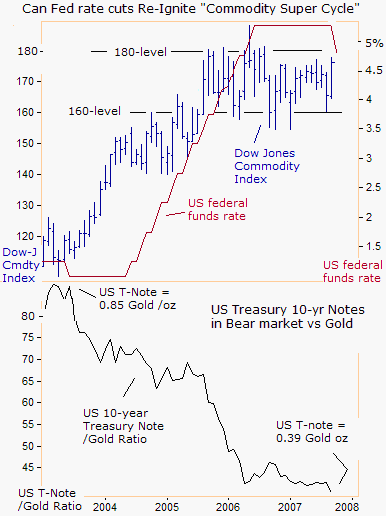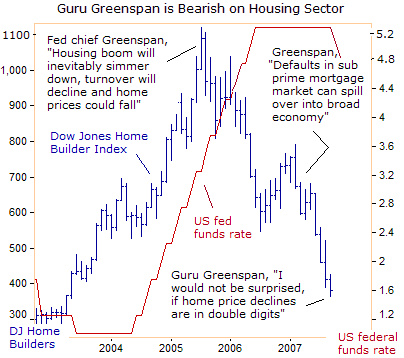|
|||
Beware - the Bernanke Fed could Ignite Hyper-Inflation!Gary Dorsch
Rod Serling was a multi-talented man and a prolific writer. His television series "The Twilight Zone" ran for five seasons in the early 1960's and was extraordinary, winning three Emmy Awards. As the host and narrator, and writer of more than half of 151 episodes, he became an American household name and his voice always sounded a creepy reminder of a world beyond our control. Nowadays, there are numerous signposts indicating that inflation in the United States is getting out of control. The US M3 money supply is 14% higher than a year ago, its fastest growth rate in 35-years, the US Dollar Index is plunging to 15-year lows, gold is surging toward $725 /oz, a 28-year high, crude oil is cruising above $80 /barrel, wheat prices have doubled to $8.75 /bushel, an all-time high, and the Baltic Dry Freight Index has zoomed 300% higher to stratospheric levels.
Could it be - the fifth dimension that lies ahead is hyper Inflation, and the re-ignition of the "Commodity Super Cycle?" Money is still pouring into commodity indexes to diversify portfolios, amid recent financial market turmoil, reaching $120 billion at the end of the second quarter, up 50% from a year earlier. Food and energy prices are sharply higher from a year ago, and this time, the surge in these "volatile components" of inflation is not a flash in the pan. But remember, you're in the "Twilight Zone," where perception is more important than reality, and emotions often trump logic. Putting it another way, "there is nothing so disastrous as a rational investment policy, in an irrational world," explained JM Keynes. Watch the dollars and cents in the Commodity Markets
However, on Sept 18th, Fed chief Ben [now aka] "B-52" Bernanke, finally showed his true colors, exposing himself as a radical inflationist, by slashing the fed funds rate a larger than expected half-point to 4.75%. The Bernanke Fed panicked, lost its cool, in a desperate attempt to bailout Wall Street brokers who peddled toxic sub-prime US mortgage slime around the world, and saddled banks and hedge funds around the world with losses to their balance sheets that can exceed $150 billion.  To defuse the credit crunch and still fend off inflation, Bernanke could have chosen the middle ground, by simply lowering the discount rate by a half-point. Instead, Bernanke chose the most aggressive action, by slashing the fed funds rate. Looking at the chart above, what impact would a series of Fed rate cuts have on the DJ Commodity Index? The Sept 21st edition of Global Money Trends presents a forecast for the DJ Commodity Index and a Sweet Sixteen model portfolio could inflate from Fed rate cuts and a further expansion of the US money supply. What's the worst possible investment to own during a series of Fed rate cuts? During DJ Commodity Index's great bull run from 2003 thru mid-2006, when it climbed 56% to a 24-year high, there was [a] simultaneous bear market for US Treasury Notes, when measured against the price of gold. This is the predicament that China finds itself in today, with an estimated $900 billion stashed away in rapidly depreciating US bonds, which have collapsed from 85-cents on the dollar to as low as 39-cents today, when measured against an ounce of glittering Gold. Can the Fed Re-Inflate sub-prime Mortgage slime? Toxic US sub-prime mortgage slime, has infected the biggest brokers on Wall Street, bond mutual funds, and the world's largest banks. Its latest victim is Northern Rock NRK.L, the UK's fifth largest mortgage lender, now bracing for a takeover after its shares collapsed and its customers lined the streets to withdraw their money. Last week, NRK.L confessed that has a £275 million exposure to US sub-prime mortgage slime. It also has a £325 million position in structured investment vehicles, requiring an advanced degree in calculus to figure out. To make matters worse, about 5 million adjustable-rate US mortgages (ARMs) are slated to reset in the next 18-months. More than two million of these ARMs are sub-prime and as many as 600,000 sub-prime borrowers could lose their homes, weighing on an already weak housing market. The US housing slump could deepen if sub-prime borrowers who took out ARMs in 2004 and 2005 to secure low teaser rates for the first two or three years of the loan are forced to refinance their loans at higher interest rates, while home values stagnate or fall.  Already, there are glaring signs that the US economy might be headed for a recession. Pending sales of previously owned US homes fell by a surprising 12.2% in July, while the supply of unsold homes reached 9.6 months, a 16-year high. And the US economy unexpectedly lost jobs in August for the first time in four years. Former Fed chief "Easy" Al Greenspan, said on Sept 16th, he expects "as a minimum, large single-digit percentage declines in US house prices from peak to trough, and would not be surprised if the drop was in double digits," he warned. Harvard University economist Martin Feldstein, advised the former Princeton economist "B-52" Bernanke to come to the rescue of sub-prime borrowers, with the same old magic formula - printing more money, devaluing the dollar, and lowering the fed funds rate. "There is a significant risk of a recession. Downturns in housing construction have almost always been followed by a downturn in the economy, by a recession. My judgment is there is enough of a risk that the Federal Reserve should be responding by cutting interest rates," Feldstein said on August 31st. Since the credit market crisis unfolded in early August, the Bernanke Fed has pumped $292 billion of morphine (repos) into the banking system, the most since the September 11, 2001's terror attacks on the United States. Not all the morphine has been withdrawn however, and as a consequence, the growth rate of the M3 money supply expanded to 14% in August, and gold has jumped to $725 /oz. To read the rest of this article, please click on the link below, http://www.sirchartsalot.com/article.php?id=68 Sep 19, 2007 |

 It's like entering
"a fifth dimension beyond that which is known to man, that
lies between the pit of man's fears and the summit of his knowledge.
It is an area called "the Twilight Zone," Mr Serling
explained.
It's like entering
"a fifth dimension beyond that which is known to man, that
lies between the pit of man's fears and the summit of his knowledge.
It is an area called "the Twilight Zone," Mr Serling
explained.